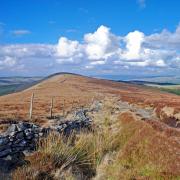As the summer continues to heat up, people naturally flock to the county’s rivers seeking sanctuary from the sun.
From fast flowing streams in the Dark Peak to the meandering and majestic Trent further south, waterways are a core element of the culture and landscape of Derbyshire.
Seemingly providing a sanctuary for water life, under the surface, Derbyshire Wildlife Trust, which has been protecting wildlife and wild spaces in the county since 1962, warns that not all is well down by the river.
As such, work to restore rivers in our county is underway and the Trust is asking for more rights for rivers.

Flooded with wildlife
Flowing water has an awesome power, with the ability to carve and shape a landscape, determine its natural patterns and influence its history too.
No two sections of a river are the same. The tiniest of variations, even a single boulder, creates endless variety.
An unpredictable upland stream can have highly oxygenated waters, low in nutrients and therefore support unique and rare aquatic life such as stonefly and mayfly nymphs.
Slower lowland rivers are modified in many places and carry nutrient enriched waters which encourage plants such as reedmace and burr reed.
And where these rivers run over sandstone or gravels, rock clinging wavy beds of water crowfoot shelter.
Tread quietly enough by the river and you could see kingfishers, grey wagtails and dippers exploring pools, gravel shoals and tree-root hollows for beetle larvae and small fish fry.
Earlier in the summer, clouds of mayflies emerged to lay eggs having lived most of their life underwater as nymphs. And now, dragonflies hawk along the banks by day, while bats sweep across the surface feeding on moths by night.
Once we begin to approach the autumn months, Atlantic salmon can be glimpsed charging powerfully up the weir slopes of larger rivers, with their smaller cousins the brown trout hustling up the fish passes which have been added to ease their way.
But despite being home and sanctuary to so much life, the pressures on our natural river systems are immense.
Pollution from agriculture and road run-off leads to sediment and harmful chemicals impacting water quality. Over-abstraction can cause increased toxicity levels and lack of water for aquatic life. Reduction of tree cover leads to higher water temperatures and consequently low oxygen levels harmful to fish.

Conserving the flow
River conservation means taking a catchment approach. Derbyshire Wildlife Trust is working with others and creating a broad range of projects and activities to create a river recovery network.
Most recently, a project to restore the natural habitat of the River Ecclesbourne and support the recovery of Atlantic salmon has got underway.
Working with partners at the Wild Trout Trust, Chatsworth Estate, and Nestlé Waters, Derbyshire Wildlife Trust is managing a new project to improve water quality, enrich the ecological status of the river and re-meander a section of the river back to its original channel.
This will bypass a weir at the site of the former Postern Mill in Turnditch and create a route for fish migration.
A tributary of the River Derwent, the Ecclesbourne rises near Wirksworth and flows southeast for approximately 18km to join the Derwent near Duffield.
The ecological status of the river is classed as ‘moderate’ against the Water Framework Directive by the Environment Agency, due to pollution and physical barriers preventing fish movement throughout the watercourse.
A Wild Trout Trust habitat assessment reports that the river has a large amount of potential spawning habitats for Atlantic salmon, a priority conservation species, and other fish species found in the Derwent Catchment, but their movement is prevented by the presence of manmade structures.
The project will bypass the weir and restore the river to its original course before it was diverted for milling in the 18th century, opening over 28km of river and tributaries for fish, and improving the ecological status of the river.
The excavation and construction of the new channel, due to start in the Autumn, will reinstate fish passage for many species, including salmon, classified as ‘vulnerable’ in Europe, and eel classified as ‘critically endangered’ globally by the International Union for Conservation of Nature.
Other species to benefit include grayling, trout, lamprey, minnow, stone loach, and bullhead.
Fight for its right to flow
The reality is that only 14 per cent of England’s rivers are classified as being in ‘good’ ecological status by the Environment Agency. In all likelihood, those figures are an overestimate and don’t truly reflect the scale of the problem.
Derbyshire, unfortunately, is no exception. Campaign group Top of the Poops ranked the River Derwent as the fifth most polluted across England and Wales in 2021.
‘For centuries, we’ve treated the natural world as an ever-present resource available for exploitation,’ says Scott Blance, advocacy manager at Derbyshire Wildlife Trust.
‘Viewing nature as something to be controlled and exploited has turbocharged industrialisation but has driven nature to the brink.
‘Existing regulatory approaches to environmental protection aren’t working because pollution and habitat degradation continue to accelerate.
‘What we need is a new approach that respects the inherent value of the natural world and gives it a stronger voice in society. Business as usual isn’t protecting our rivers and a new approach is needed.’



























